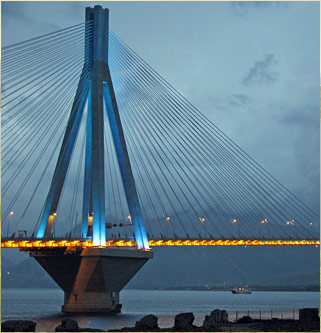|
|
 |
 |
 |
|
 |
 |
|
 |
|
|
|
 |
|
|
|
The small suburban town of Rio, or Rion, is situated north of Patras, Greece. Regarded as being mainly a township of weekend visitors, its population is relatively small at around five to six thousand. Most of the houses are squeezed between the freeway barriers and the beach, offering the locals a spectacular view of Aetoloacarnania (Acarnania), northwestern Peloponnese, including Patras and southwestern Phokis, and the Panachaicus mountains. While agriculture and farmland used to dominate Rio, the area is showing signs of change. With the influx of wealthier inhabitants from Patras, new luxurious houses, a hospital and even a university have been erected. Rio is a perfect beach town retreat for travelers, with its sandy beaches to the west, an ancient fortress situated in the center and a harbor located northwest of downtown. There is a lot to see and soak in during your visit here as this community has existed for over 3,000 years.
|
|
|
Castello di Morea
Castello di Morea is a remarkably well-preserved 14th century stronghold built alongside the Gulf of Corinth. Standing watch out over the narrows between the Gulf of Patras and the Gulf of Corinth, this fort was used by invaders and conquerors alike as new rulers and empires rose and fell. The fort actually consists of two buildings, one on either side of the narrows. Known today as Castle of Rion (Morea) and Castle of Antirion (Rumelia), the fortresses on the Peloponnesian coast were originally named Castello di Morea (as the Peloponnese was named during the Venetian conquest), and Castello di Rumelia.
Ferry and Camping
Rio’s harbor offers a ferry service to nearby ports including Antirrion, which links the Peloponnese with mainland Greece. Beside the landing stage is the Castle of Rion (Morea). For travelers on a budget, there is a campground located within Rio Beach: Camping Rio Beach.
Rio-Antirio Bridge
Inaugurated on August 7, 2004, this cable-stayed bridge is the second link between the Peloponnese and the western part of mainland Greece. One week later, the 2004 Summer Olympics were set to begin in Athens and the Olympic torchbearers were the first to officially cross the Rio-Antirio Bridge. Consisting of five cable-stayed spans and four columns, it spans a length of 2,252 meters, making it the world’s longest cable-stayed suspended deck. The bridge is said to be an engineering masterpiece because of the unusual conditions of the straits, which include deep water, an insecure seabed foundation and seismic activity, not to mention the fact that the Gulf of Corinth is expanding at a rate of 30 millimeters per year due to plate tectonics. Be sure to see the bridge at night when it is illuminated.
Gulf of Patras
The Gulf of Patras is a massive body of water stretching from the eastern part of the Ionian Sea up to the Strait of Rion, finishing at the capes of Rio and Antirio. The gulf’s length is approximately 40 to 50 kilometers and ranges in width from between 10 to 20 kilometers. The famous Port of Patras lies to the southeast and is the only major port on the gulf.
|
 |
|
|
 |
 |
 |
 |
 |
|
All THE AMAZING RACE related graphics and photos on this page are copyright 2006 CBS Broadcasting Inc.
This website IS NOT affiliated with the CBS Broadcasting Inc.
|
|



